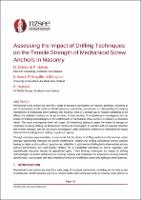| dc.contributor.author | Dizhur, Dmytro | |
| dc.contributor.author | Galvez, Francisco | |
| dc.contributor.author | Noori, Kia | |
| dc.contributor.author | Orquillo, Pauline | |
| dc.contributor.author | Ingham, Jason M. | |
| dc.contributor.author | Hudson, Robert | |
| dc.date.accessioned | 2024-07-01T02:01:12Z | |
| dc.date.available | 2024-07-01T02:01:12Z | |
| dc.date.issued | 2024-04-09 | |
| dc.identifier.uri | https://repo.nzsee.org.nz/xmlui/handle/nzsee/2708 | |
| dc.description.abstract | Mechanical screw anchors are used for a range of structural connections on masonry buildings, including as part of earthquake retrofit solutions. While extensive research has been devoted to understanding the working mechanisms of mechanical screw anchors into masonry, there is a critical gap in research pertaining to the effects of installation methods on the performance of these anchors. A comprehensive investigation into the impact of drilling methodologies on the performance of mechanical screw anchors in masonry is presented herein. The study encompasses three key stages: i) overarching testing to assess the extent of damage on substrates caused by drilling, ii) blowout and microcrack investigation to quantify pull-out capacity reduction due to these damages, and iii) microcrack investigation under controlled conditions to understand the impact internal microcracking due to drilling on pull-out capacity.
Through extensive experimentation, it was found that the choice of drilling method and the hammer action intensity significantly influence the anchor performance. Rotary-only drilling consistently proved superior leading to higher anchor pull-out capacities and reliability. Light-hammer drilling led to intermediate anchors pull-out performance and hard-hammer drilling led to substantial reductions in anchor capacities and unpredictable outcomes despite its operational speed. These findings underscore the impact of drilling methodologies on anchor performance in existing masonry and emphasises the importance of using material specific tools, such as spear drill bits, to facilitate effective and efficient rotary only drilling in these materials. | |
| dc.language.iso | en | |
| dc.publisher | New Zealand Society for Earthquake Engineering | |
| dc.relation.ispartofseries | 2024;39 | |
| dc.subject | Seismic performance, risk mitigation and resilience of new and existing structures | |
| dc.title | Assessing the Impact of Drilling Techniques on the Tensile Strength of Mechanical Screw Anchors in Masonry | |
| dc.type | Article | |

